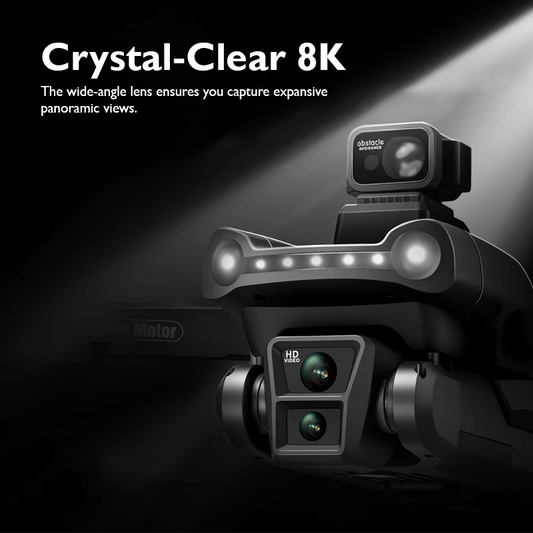The Best Drones for Monitoring Oceanic Wildlife

In the expansive world of conservation and marine biology, the utilization of drones has revolutionized the way we observe and protect oceanic wildlife. These technological marvels provide researchers, scientists, and conservationists with unparalleled access to remote areas and elusive marine species, allowing for crucial data collection and monitoring efforts. Whether it's tracking migratory patterns, assessing population dynamics, or conducting environmental assessments, the best drones for monitoring oceanic wildlife play a pivotal role in advancing our understanding and stewardship of the marine environment.
In this comprehensive guide, we'll delve into the top drones specifically designed for monitoring oceanic wildlife, highlighting their features, capabilities, and how they contribute to conservation efforts worldwide.
Understanding the Importance of Drone Technology in Marine Conservation

Before we dive into the specifics of drone models, it's essential to grasp why these aerial devices are indispensable tools for marine conservationists.
i. Enhanced Accessibility: Drones offer access to remote and inaccessible areas of the ocean, such as offshore habitats and marine reserves, where traditional monitoring methods may be impractical or costly.
ii. Minimal Disturbance: Compared to manned aircraft or boats, drones produce minimal noise and disturbance, making them ideal for observing sensitive marine wildlife without causing undue stress or disruption.
iii. High-resolution Imaging: Advanced camera systems mounted on drones capture high-resolution imagery and video footage, allowing researchers to conduct detailed surveys and assessments of marine ecosystems and wildlife populations.
iv. Cost-effectiveness: Over time, drone technology has become more affordable, making it accessible to a broader range of organizations and researchers, thereby democratizing marine conservation efforts.
The Top Drones for Monitoring Oceanic Wildlife
1.DJI Phantom 4 Pro

Key Features: Equipped with a high-resolution camera capable of capturing 4K video and 20-megapixel stills, the DJI Phantom 4 Pro offers exceptional image quality for wildlife monitoring.
Benefits: Its long flight time and advanced obstacle sensing capabilities make it well-suited for conducting extended surveys over vast oceanic areas while ensuring safe operation.
Applications: Ideal for tracking large marine mammals, such as whales and dolphins, and conducting aerial surveys of coastal habitats and nesting sites.
2.Parrot Anafi USA

Key Features: Designed for rugged environments, the Parrot Anafi USA boasts a compact and foldable design, making it highly portable for field deployments.
Benefits: With its thermal imaging capabilities, the Anafi USA can detect heat signatures, making it invaluable for locating marine wildlife, including sea turtles, manatees, and seals, even in low-light conditions.
Applications: Suitable for monitoring marine biodiversity, detecting illegal fishing activities, and conducting search and rescue operations in coastal areas.
3.Yuneec Typhoon H Pro

Key Features: The Yuneec Typhoon H Pro features a six-rotor design for enhanced stability and maneuverability, making it ideal for capturing steady footage in windy marine environments.
Benefits: Its retractable landing gear and 360-degree rotating camera gimbal allow for unrestricted views and versatile imaging angles, crucial for detailed marine surveys and behavioral observations.
Applications: Well-suited for studying seabird colonies, coastal erosion, and coral reef health, the Typhoon H Pro is a versatile tool for various marine research applications.
4.SplashDrone 4

Key Features: Built specifically for maritime operations, the SplashDrone 4 is waterproof and buoyant, capable of landing and taking off from water surfaces, making it uniquely suited for marine wildlife monitoring.
Benefits: Its payload release mechanism enables researchers to deploy scientific instruments, such as water samplers or biologging tags, directly from the drone, facilitating data collection without human intervention.
Applications: From studying marine mammal behavior to monitoring marine debris accumulation, the SplashDrone 4 excels in maritime environments where other drones may struggle to operate effectively.
As marine ecosystems face unprecedented threats from climate change, pollution, and overexploitation, the need for innovative technologies like drones has never been greater. By harnessing the power of these aerial platforms, researchers and conservationists can gain valuable insights into the dynamics of oceanic wildlife and ecosystems, informing evidence-based management strategies and conservation interventions.
Whether it's the DJI Phantom 4 Pro's unparalleled imaging capabilities or the SplashDrone 4's specialized features for maritime operations, each drone on our list offers unique advantages for monitoring oceanic wildlife. By choosing the right tool for the job and leveraging the latest advancements in drone technology, we can continue to safeguard our oceans and preserve their rich biodiversity for future generations.
Explore a variety of drones at our online drone store.Happy Flying!











